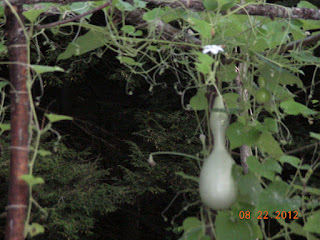1. Patio using existing wood chips cost me only the landscape fabric underneath. I found stone to trim the patio.
 | ||
| Before (spring 2012) |
 |
| woodchip patio area (summer 2012) |
3. The area in front of the hives was enhanced with a rustic archway and four half circle(ish) gardens with a grass path that divides them. Over the archway, I planted the gourds for fast growth. Once morning glories are established, they would fill an archway nicely too. Perhaps another year :).
 |
| Birdhouse gourd growing on rustic archway |
4. This is the beehive area where I moved my cherry, peach and apple trees where they'd be protected by the electric fence, at least during the summer. I left another apple tree outside the fenced area I did get 8 peaches, perfectly ripened and made a peach tart which I then froze and will serve it at Thanksgiving. I didn't expect anymore fruit this year but am hoping to see a bit more next year. This is the beginning of the landscaping project.
 | |||
| setting up beehive area and planning the garden - before shot |
 | ||
| Spring garden in process |
 |
| August 2012 |
The bush on the left is a PeeGee Hydrangaea. I planted White Alyssum around the edges
Behind that bush I already had the gooseneck loosestrife around the edges and the tall sunflower-like plants there, with a Valerian plant at either side in the back. I then added a few Cosmos for late fall color. Those are not in bloom yet...almost. The gooseneck loosestrife is invasive so I've been deadheading the blooms to keep them under control.
On the right, the back garden has a few butterfly bushes toward the back which may need to be moved because it's not getting enough sunlight there. I'll need to plant something that likes partial shade there next year I'm actually thinking that a rhododendron might work there. And I planted creeping thyme around the edge of that garden which blooms pink in the spring so will need a color to coordinate
In the front on the right is mostly annuals with the exception of a Broomstick plant that I'm hoping will take off here. If it does, it will bloom in yellow in the spring
The gardens themselves will change over time and I'll try to make them as carefree as possible...probably using shrubs rather than annuals or perenniels. But that planning is all part of the fun and it is winter fun so stay tuned for more ideas during the winter.








 The piece of wood you see across the top if this has a screw in the middle that you rest the frame on as you are running the comb down over the frame to allow the honey to flow.
The piece of wood you see across the top if this has a screw in the middle that you rest the frame on as you are running the comb down over the frame to allow the honey to flow.


